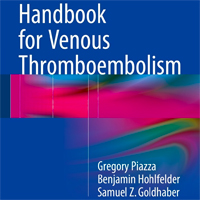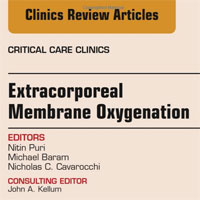Tag: DVT
Baricitinib Use in Children with Severe COVID-19 Infection
Baricitinib appears safe for both immunocompetent and immunocompromised children hospitalized for severe COVID-19. Most adverse events did not inhibit therapy administration, and there were no deaths following the initiation... read more
Nebulized Furosemide Effect on the Mortality of Mechanically Ventilated ARDS Adult Patients
This RCT tackles an important topic in critical care medicine, which involves a large number of critically ill patients and continues to harbor high mortality despite improvements in management. The results of the study... read more
Handbook for Venous Thromboembolism
A truly practical guidebook for anyone who needs the key information on the diagnosis, management and prevention of venous thromboembolism. Specific areas of focus include understanding the risk factors for VTE and the role... read more

Atypical Presentation of Pulmonary Embolism in Patients with Refractory Hypoxemia and Dyspnea
Pulmonary embolism (PE) should be strongly considered in patients presenting with refractory hypoxemia and dyspnea, even in the absence of clinical signs of deep vein thrombosis (DVT). This study highlights the importance... read more
Antithrombin III Levels and Outcomes Among Patients With Trauma
In this cohort study of trauma patients, antithrombin III deficiency was associated with greater severity of illness and worse hospital outcomes. Specifically, antithrombin III deficiency was associated with fewer ventilator-free... read more
tPA for Critically Ill ICU Patients with COVID-19: Does Alteplase Help?
How do you define a last-ditch effort to save someone's life from COVID-19? Perhaps giving tPA to a severe COVID patient? At this point, I am certain many of us have attempted, with informed consent of course, therapies for... read more
VTE Diagnosis and Treatment in the COVID-19 Era
This is a very interesting time to be an intensivist with a research interest in blood clots. As such I wanted to use this time to talk about how COVID 19 has changed our approach to diagnostics, therapeutics and even to... read more
A Rare of Case of COVID-19-Related Pericardial Effusion and Cardiac Tamponade
Acute pericarditis involves inflammation of the pericardial sac, which is made of an inner mesothelial visceral layer that surrounds the heart. Normally, this layer produces ~50 mL of fluid to lubricate the heart and... read more
Venous Thromboembolism Prophylaxis in Critically Ill Adults
Among critically ill adults, compared to control, low molecular weight heparin (LMWH) reduces incidence of deep venous thrombosis (DVT) while UFH and mechanical compressive devices may reduce risk of DVT. LMWH is probably... read more
Ground-breaking Research – Venous Thrombosis is Back in Business
The primary efficacy outcome was the development of a major venous thromboembolic event such as symptomatic distal or proximal deep-vein thrombosis, asymptomatic deep vein thrombosis, pulmonary embolism or venous thromboembolism–related... read more
Spontaneous Echo Contrast in Venous Ultrasound of Severe COVID-19 Patients
Initial reports have indicated a higher incidence of venous thromboembolism (VTE) among patients with coronavirus disease 2019 (COVID-19) compared to other critical illnesses. Helms et al. found pulmonary embolisms in 25%... read more
New NICE Guidelines on VTE Management
In the midst of everything that is going on with COVID-19 it is easy to see how important non coronavirus stuff can get overlooked. But we still need to keep our eyes open. After a 3 year process involving many meetings,... read more
Blood Grouping Identifies Patients at Risk for Developing Venous Thromboembolism
Based on study of more than 28,000 TJA patients, presurgical ABO blood group testing looks like an inexpensive way to identify patents at increased risk for symptomatic postoperative VTE. Prophylaxis regimens can dramatically... read more
Thrombosis and Bleeding in the ICU
ICU patients are high risk of developing thrombotic complications such as deep venous thrombosis (DVT) and pulmonary embolism (PE). Indeed, due to the hypercoagulative state typical for many forms of critical illness associated... read more
EHR-guided Strategy Reduces Postop VTE Events
By incorporating algorithms into the electronic health record (EHR), UPMC was able to realize a "dramatic" 72% reduction in missed doses, from 4,331 missed doses in 2014 to 1,193 in 2015, Dr. Neal told attendees in a session... read more
Subsegmental Pulmonary Embolism: Anticoagulation or Observation?
As the use of chest CT-angiograms in emergency departments and medical wards has risen by more than tenfold, so has the discovery of small pulmonary emboli of unclear clinical significance. These PEs are often isolated to... read more
ECMO, An Issue of Critical Care Clinics
This issue of Critical Care Clinics focuses on Mechanical Circulartory Support. Editors Nitin Puri and Michael Baram have assembled an expert team of authors on topics such as: History of Extracorporeal Membrane Oxygenation... read more

The YEARS Study – Simplified Diagnostic Management of PE
The clinical diagnosis of pulmonary embolism (PE) can be challenging given its variable presentation, requiring dependence on objective testing. Decision instruments such as PERC and the Wells' score help stratify patients... read more
Venous Thromboembolism Prophylaxis in Major Orthopedic Surgery
Few head-to-head treatment comparisons have sufficient evidence. Most studies evaluated low molecular weight heparin (LMWH), not low-risk interventions (such as aspirin and mechanical devices); most reported on total deep... read more
Principles learned from a successful VTE improvement program
Principles learned from a successful improvement program can increase compliance and reduce hospital acquired VTEs (HA-VTEs) across multiple institutions. Can a single institution’s VTE prophylaxis program be scaled to... read more
Which position is safest for central line placement: subclavian, jugular, femoral?
Where to place a central venous catheter is a decision driven mainly by individual experience and preference. The limited evidence available has not established any site as superior; the subclavian position has been reported... read more
IVC Filters Provide No Advantage in Trauma Care
Trauma patients who received an inferior vena cava (IVC) filter to prevent pulmonary embolism (PE) had no survival advantage, according to a new study.... read more









